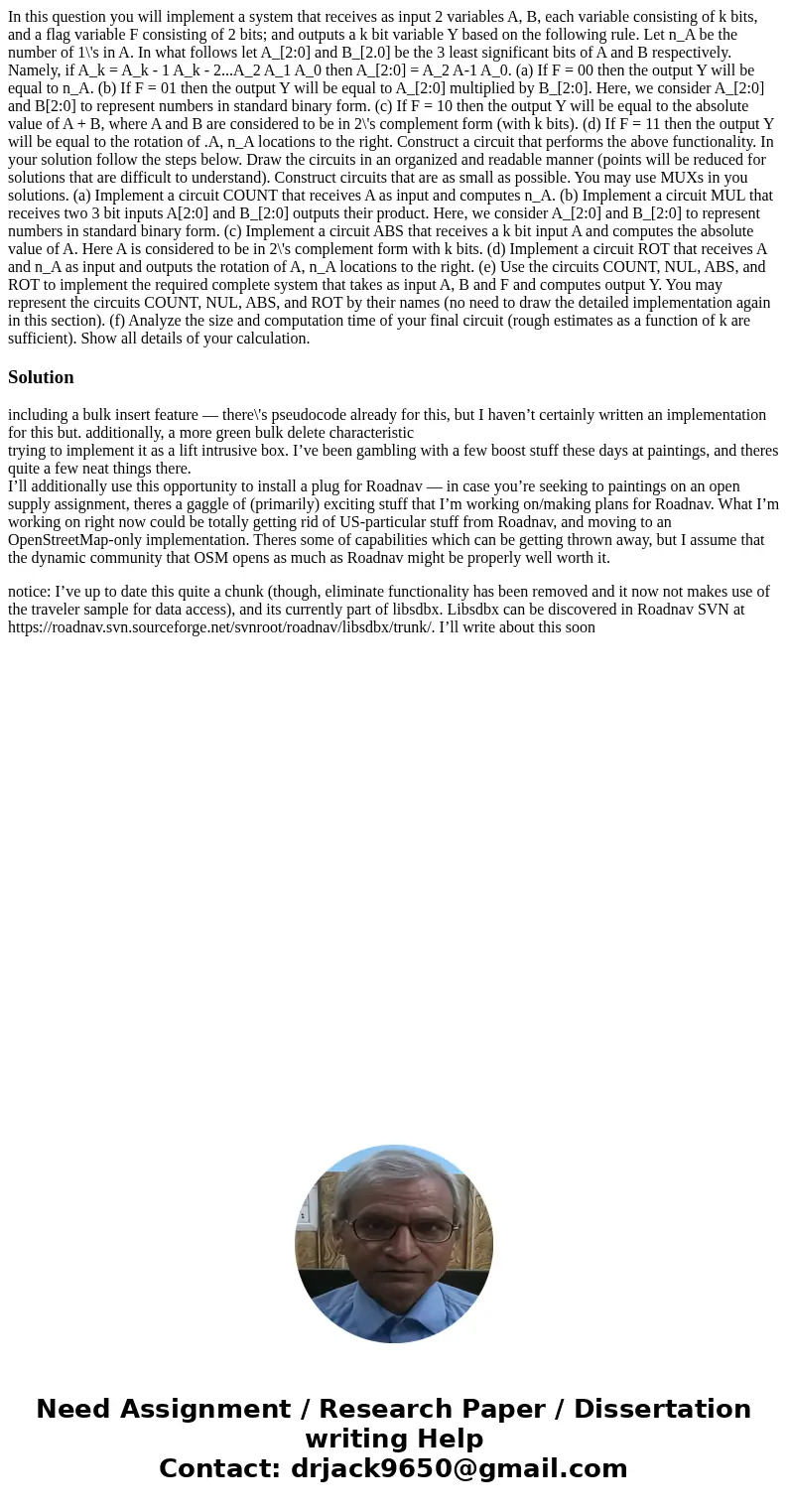In this question you will implement a system that receives as input 2 variables A, B, each variable consisting of k bits, and a flag variable F consisting of 2 bits; and outputs a k bit variable Y based on the following rule. Let n_A be the number of 1\'s in A. In what follows let A_[2:0] and B_[2.0] be the 3 least significant bits of A and B respectively. Namely, if A_k = A_k - 1 A_k - 2...A_2 A_1 A_0 then A_[2:0] = A_2 A-1 A_0. (a) If F = 00 then the output Y will be equal to n_A. (b) If F = 01 then the output Y will be equal to A_[2:0] multiplied by B_[2:0]. Here, we consider A_[2:0] and B[2:0] to represent numbers in standard binary form. (c) If F = 10 then the output Y will be equal to the absolute value of A + B, where A and B are considered to be in 2\'s complement form (with k bits). (d) If F = 11 then the output Y will be equal to the rotation of .A, n_A locations to the right. Construct a circuit that performs the above functionality. In your solution follow the steps below. Draw the circuits in an organized and readable manner (points will be reduced for solutions that are difficult to understand). Construct circuits that are as small as possible. You may use MUXs in you solutions. (a) Implement a circuit COUNT that receives A as input and computes n_A. (b) Implement a circuit MUL that receives two 3 bit inputs A[2:0] and B_[2:0] outputs their product. Here, we consider A_[2:0] and B_[2:0] to represent numbers in standard binary form. (c) Implement a circuit ABS that receives a k bit input A and computes the absolute value of A. Here A is considered to be in 2\'s complement form with k bits. (d) Implement a circuit ROT that receives A and n_A as input and outputs the rotation of A, n_A locations to the right. (e) Use the circuits COUNT, NUL, ABS, and ROT to implement the required complete system that takes as input A, B and F and computes output Y. You may represent the circuits COUNT, NUL, ABS, and ROT by their names (no need to draw the detailed implementation again in this section). (f) Analyze the size and computation time of your final circuit (rough estimates as a function of k are sufficient). Show all details of your calculation.
including a bulk insert feature — there\'s pseudocode already for this, but I haven’t certainly written an implementation for this but. additionally, a more green bulk delete characteristic
trying to implement it as a lift intrusive box. I’ve been gambling with a few boost stuff these days at paintings, and theres quite a few neat things there.
I’ll additionally use this opportunity to install a plug for Roadnav — in case you’re seeking to paintings on an open supply assignment, theres a gaggle of (primarily) exciting stuff that I’m working on/making plans for Roadnav. What I’m working on right now could be totally getting rid of US-particular stuff from Roadnav, and moving to an OpenStreetMap-only implementation. Theres some of capabilities which can be getting thrown away, but I assume that the dynamic community that OSM opens as much as Roadnav might be properly well worth it.
notice: I’ve up to date this quite a chunk (though, eliminate functionality has been removed and it now not makes use of the traveler sample for data access), and its currently part of libsdbx. Libsdbx can be discovered in Roadnav SVN at https://roadnav.svn.sourceforge.net/svnroot/roadnav/libsdbx/trunk/. I’ll write about this soon

 Homework Sourse
Homework Sourse